Hi everyone!
My name is Petr, I’m a sound designer, working for Mono Studio on InSomnia project. In this article I want to tell shortly about sound design process of heavy armour. Here is how the final result looks like:
In this work I will not use the famous audio-middleware (Wwise, Fmod), and will achieve the same results only with Unreal Engine 4 (UE4) built-in audio system.
Project Plan
All work process can be divided in a few steps:
- Concept. Thinking about how we would do the sound? How we would implement it?
- Sound design in DAW. Preparing all the wav-files.
- Sound design in UE4. Importing the wav-files, creating the audio-assets, implementing them in animation-assets.
Let’s get more closer look to each step.
1.Concept
The main style of the game is dieselpunk so we will focus on mechanical sounds. No electronics or sci-fi things. It is not a robot, it is a human covered with heavy metal armour with some sort of mechanisms and systems.
This armour is heavy and valuable thing in our game. The sound definitely will not be tiny or cute. When we see this thing in game we must feel that this is serious guy and you can easily get some troubles, so it’s better to stay away.
Let’s get closer look to the character - he wears the helmet, have a bag with some systems (let’s assume that it have some kind of liquid inside ), and the whole armour feels pretty agile - it has many mechanic details and components. We will use it as a basic sound categories:
- Voice.
- Bag.
- Metallic/mechanic sounds.
Short graphic explanation (click to enlarge):
For a voice we will use a common human breathing but with liquid components, also we will put some effects on it to achieve the voice-inside-helmet feeling. For the bag we will use liquid and acid components. For the metallic/mechanic parts we will use metallic squeaks, servo-sounds and various mechanic rattles.
We will implement all this stuff using the common UE4 capabilities - Sound Cue’s and event-attachment system inside the animation assets.
2.Sound Design in DAW
For the purpose of sound design I use Ableton Live Suite because it already have simple and interesting plugins inside and the overall design of software aimed to the fast-paced workflow.
For the rough sounds we was planning to record some stuff by ourselves. But when we breakdown all the budget that we will need for buying the hardware, constructing the foley-room, time for recording and editing, we consider that this will be our next level. We are just the indie-studio somewhere in the middle of development of our first project, so let’s just work with sound-libraries for now. The exception for this statement is the voice. After test recordings we realize that we can do it by ourselves.
2.1.The Voice
For the voice recording I use russian microphone Oktava MK-012 with the capsule from MK-101. This is pretty cheap mic but considering the heavy treatment, the quality of rough recording is not so valuable. Here’s how the rough voice sound like:
And here is how this voice sound after the post-processing:
The main idea of the post-processing consists in using of vocoder as the central element. Just mix voice with liquid (bubbles) inside it and treat the results with other effects afterwards. Here is my detailed scheme of processing with all settings (click to enlarge):
2.2.The Bag
For bag sound design we will use next rough sounds:
- Steam.
- Water bubbles - connection with voice sounds.
- Ableton’s Analog synth with bubbling sound - for additional color. We will use A note sound (A-1) because the primary tune of the game is A-minor. Of course this sound will be more subtle but it’s good to know that even there we are using the right notes.
- Light electric sparkles.
- Acid hiss.
Mixing all this stuff, processing and getting this result:
Here is my detailed scheme of processing with all settings (click to enlarge):
2.3.Metallic/mechanic sounds
The main part of sound design that defines that we have metallic armour. Here we will not use weird processing, only common layering and equalizing of rough sounds. As an example of completed sound I want to discuss the dead of the character. At first we hear the hit (impact of something undefined) followed by squeaks of bending metal and then comes the fall event. Here is how it looks in the DAW (you can see the layers of sound samples, click to enlarge):
Here is how it sounds:
After we’ve rendered all wav-files, we must put them in audio editing software (I use Adobe Audition) to polish them for best possible sounding (cut the ending silence, delete unwanted clicks and other artifacts). All files must be 44.1kHz, 16 bit, mono. At the end we will have the sfx-pack ready for UE4 implementation.
2.Sound Design in Unreal Engine
Finally our task is to implement wav-files in UE4 and set them up properly to achieve the same sound that we’ve done in DAW. Importing our sfx-pack, creating properly named Sound Cue assets (event name = Sound Cue name). At this part of work I split the assets to our three categories: voice, bag and armour (metal/mechanic sounds). This is done due to InSomnia’s naming system. We store the voice and footsteps separately. Put all this sounds in one asset will be illogical. However this will be more handy to have one asset that stores all files. But for this project we will follow the existing logic.
When we create the Sound Cue assets our primary instruments (Sound Nodes) are:
- Modulator - modulates every iteration of sound by pitch and volume.
- Random - randomly selects one sound from all that we offer to him.
Here is how the Sound Cue for footsteps looks like (click to enlarge):
We can see both Random (which selects one sample of those who were present) and Modulator (randomly modulates selected sample). Also we see two different packs of footsteps - first one have «harm» inside his naming, and second one have «harm1». This appears due to the fact that we was planning to do two different kinds of heavy armour that must sound different. But due to the technical reasons we can’t implement this feature right now. But we keep this separation for the future. «harm» stands for common low-frequency sounds, and «harm1» for high frequency sounds. So if someday we will have the second heavy armour sound-pack back in business, we will use the files that have «harm2» inside their naming. Thе second heavy armour is more chain-style so here is the place when we can take it in account regarding to the sound design.
Next step is to put Sound Cue’s into the animation assets. For example here is the run animation window (click to enlarge):
In conclusion I want you to rewatch the whole video with all that information in mind:
In video:
- Right part of the screen - animation assets with timeline and mapped Sound Cue’s.
- Left part of the screen - Sound Cue assets implemented in this animation asset.
As the lines getting highlighted you can trace the sound flow from the original wav-file to the exit of the Sound Cue.
Hope this article will help anyone who interested in UE4 sound design workflow. Thanks for reading!
P.S.: If you want to know more about InSomnia project please visit our site and also here is the Mono Studio facebook page. This post is translation from my original russian post on habrahabr. Original english version also can be found on Gamasutra. Please feel free to mail me (peter@headshotlab.com) or write in comments if you will see the language issues that bothered you. Many thanks!
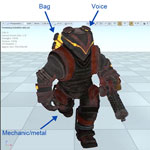
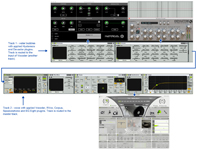
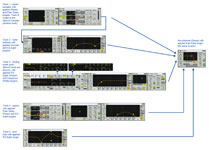
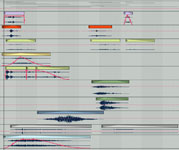
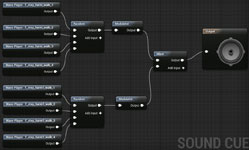
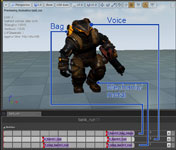



this is some complex sound engineering for a character, I like it